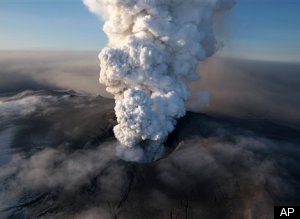 |
| "One thing I can tell you is I gotta be free" |
I. Background
This series posits the hypothesis that global warming induced climate change will impact both earthquakes and volcanoes.
It is backed by science based on both non-Anthropogenic eras prior to the current Anthropogenic era, as well as the current era.
The embryonic form of the ideas this post illustrates was set forth in an earlier post over eight years ago:
"In August of 2007, over 2.5 years ago, a geologist had studied the historical record for global warming events which were not anthropogenic (not caused by human activity).(Global Warming & Volcanic Eruptions, April 17, 2010). Yes, a little bit over eight years ago the subject of how climate change could impact volcanoes and earthquakes in the future was considered.
His conclusions were that global warming has caused volcanic eruptions and earthquakes in the ancient past.
He went on to say that the anthropogenic global warming occurring now will do so too."
Not only that, the scientist quoted in that post had also provided a prediction:
"In places like Iceland, for example, where you have the Eyjafjallajökull ice sheet, which wouldn't survive [global warming], and you've got lots of volcanoes under that, the unloading effect can trigger eruptions," McGuire said.(ibid). Not long after that the ice thickness at that glacial field thinned enough for the volcano to become uncorked.
With the changing dynamics in the crust, faults could also be destabilized, which could bring a whole host of other problems.
"It's not just the volcanoes. Obviously if you load and unload active faults, then you're liable to trigger earthquakes," McGuire told LiveScience, noting that there is ample evidence for this association in past climate change events.
The consequent eruption, among other things, shut down air travel in Europe.
II. The Present Situation
The current series, on the heels of that post, pondered the scope of the potential we were considering, via a question (Is A New Age Of Pressure Upon Us?, 2, 3, 4, 5, 6, 7, 8, 9, 10,11, 12, 13, 14).
Specifically, in the most recent post of this series I reiterated:
In the previous post of this series on the Dredd Blog System, I detailed the history of this question going back almost eight years.(Is A New Age Of Pressure Upon Us? - 14). Now, we can add an interesting development to the mix.
In that post I pointed out the gist of this subject:
"The impacts I am now talking about are the changes in pressures upon the Earth's crust which take place in a very wide span of the ocean basins.(Is A New Age Of Pressure Upon Us? - 13). Like the ghost water discussions here on Dredd Blog were substantiated (NASA Busts The Ghost), a recent paper now upholds the pressure change hypothesis (Ocean Bottom Deformation Due To Present-Day Mass Redistribution and Its Impact on Sea Level Observations, PDF).
Those impacts concern both a decrease in pressure in some areas, as well as an increase of pressure in other areas."
III. The New Discovery In Antarctica
A few days ago, a submission at Nature mentioned that a volcano has been discovered to exist somewhere underneath the Pine Island Glacier.
But more than that, it seems to be exuding problematic elements:
“We were looking to better understand the role of the ocean in melting the ice shelf,” Loose said. “I was sampling the water for five different noble gases, including helium and xenon. I use these noble gases to trace ice melt as well as heat transport. Helium-3, the gas that indicates volcanism, is one of the suite of gases that we obtain from this tracing method.(Evidence of an active volcanic heat source beneath the Pine Island Glacier,
“We weren’t looking for volcanism, we were using these gases to trace other actions,” he said. “When we first started seeing high concentrations of helium-3, we thought we had a cluster of bad or suspicious data.”
...
“When you find helium-3, it’s like a fingerprint for volcanism. We found that it is relatively abundant in the seawater at the Pine Island shelf.
“The volcanic heat sources were found beneath the fastest moving and the fastest melting glacier in Antarctica, the Pine Island Glacier,” Loose said. “It is losing mass the fastest.”
Nature). I should mention that a neighbor of Pine Island Glacier is "The Doomsday Glacier" which is named Thwaites Glacier (Why Sea Level Rise May Be The Greatest Threat To Civilization - 6).
The researchers went on to say "Despite the accumulation of evidence, definitive proof of contemporary subglacial volcanism in West Antarctica is still missing."
Which is another way of saying, "when the glacial ice over this puppy gets too thin, all hell will break loose."
IV. This Phenomenon Is Increasing
During the life of this series, especially recently in the Ring of Fire, Hawaii, Japan, Indonesia, Alaska, and elsewhere, things are heating up and shaking.
This is an unexpected "feedback loop."
V. Conclusion
As the ice sheets of Greenland and Antarctica (along with the land-based glacial areas of the globe) pour water and icebergs into the oceans, that water and ice is relocated to the oceans in the middle of the Ring of Fire.
That torques the crust as it floods the coasts, raises the sea level far from the coasts, and lowers the sea level near the Cryosphere concentrations (NASA Busts The Ghost).
Get used to it, a federal court has ruled you are guilty (The Psychology of the Notion of Collective Guilt - 2).
The next post in this series is here, previous post in this series is here.
"How climate change is threatening the Navy’s footprint in the Pacific" - (link)
ReplyDelete